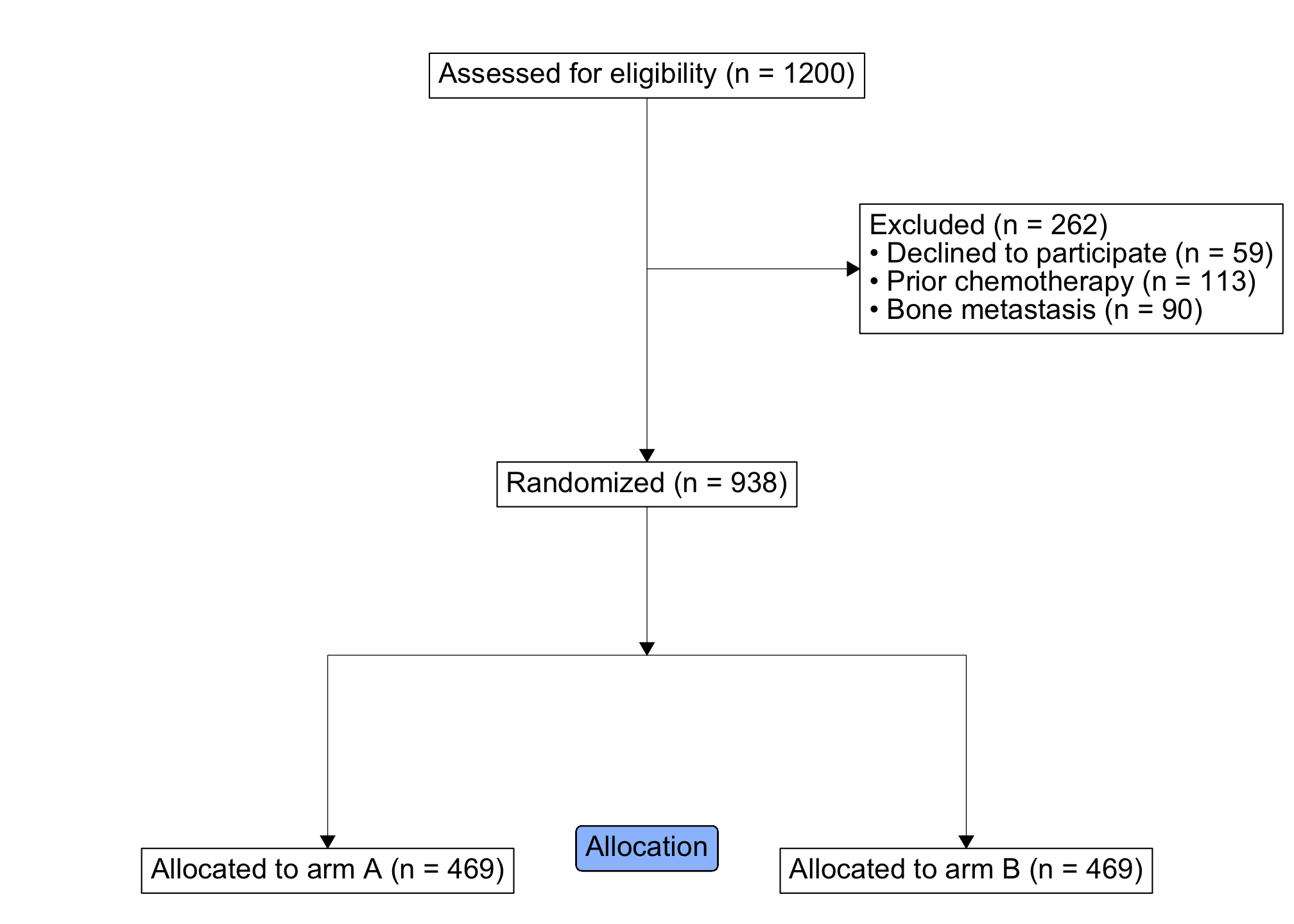The goal of ggconsort is to provide convenience functions for creating
CONSORT
diagrams
with ggplot2. ggconsort segments CONSORT creation into two stages: (1)
counting and annotation at the time of data wrangling, and (2) diagram
layout and aesthetic design. With the introduction of a
ggconsort_cohort class, stage (1) can be accomplished within dplyr
chains. Specifically, the following functions are implemented inside a
dplyr chain to define a ggconsort_cohort:
cohort_start()initializes aggconsort_cohortobject which contains a labeled copy of the source datacohort_define()constructs cohorts that are variations of the source data or other cohortscohort_label()adds labels to each named cohort within theggconsort_cohortobject
Stage 2 makes use of three ggconsort consort_ verbs which equip the
ggconsort_cohort object with ggconsort properties. The ggconsort
object can be viewed with ggplot via geom_consort() + theme_consort().
plot and print methods are also available for the ggconsort object
for visually iterative development.
consort_box_add()adds a text box to the CONSORT diagramconsort_arrow_add()adds an arrow to the CONSORT diagramconsort_line_add()adds a line (without an arrow head) the CONSORT diagram
You can install the released version of ggconsort from GitHub with:
# install.packages("devtools")
devtools::install_github("tgerke/ggconsort")To demonstrate usage, we use a simulated dataset within ggconsort called
trial_data, which contains 1200 patients who were approached to
participate in a randomized trial comparing Drug A to Drug B.
library(ggconsort)
head(trial_data)
#> # A tibble: 6 x 5
#> id declined prior_chemo bone_mets treatment
#> <int> <int> <int> <int> <chr>
#> 1 65464 0 0 0 Drug A
#> 2 48228 0 0 0 Drug B
#> 3 92586 0 0 0 Drug A
#> 4 70176 0 0 0 Drug B
#> 5 89052 0 0 0 Drug A
#> 6 97333 0 0 0 Drug BOf the 1200 approached patients, only a subset were ultimately randomized: some declined to participate or were ineligible (due to prior chemotherapy or bone metastasis). We will use ggconsort verbs and geoms to count the patient flow and represent the process in a CONSORT diagram.
We first define the ggconsort_cohort object (study_cohorts) in the
following dplyr chain.
library(dplyr)
study_cohorts <-
trial_data %>%
cohort_start("Assessed for eligibility") %>%
# Define cohorts using named expressions --------------------
# Notice that you can use previously defined cohorts in subsequent steps
cohort_define(
consented = .full %>% filter(declined != 1),
consented_chemonaive = consented %>% filter(prior_chemo != 1),
randomized = consented_chemonaive %>% filter(bone_mets != 1),
treatment_a = randomized %>% filter(treatment == "Drug A"),
treatment_b = randomized %>% filter(treatment == "Drug B"),
# anti_join is useful for counting exclusions -------------
excluded = anti_join(.full, randomized, by = "id"),
excluded_declined = anti_join(.full, consented, by = "id"),
excluded_chemo = anti_join(consented, consented_chemonaive, by = "id"),
excluded_mets = anti_join(consented_chemonaive, randomized, by = "id")
) %>%
# Provide text labels for cohorts ---------------------------
cohort_label(
consented = "Consented",
consented_chemonaive = "Chemotherapy naive",
randomized = "Randomized",
treatment_a = "Allocated to arm A",
treatment_b = "Allocated to arm B",
excluded = "Excluded",
excluded_declined = "Declined to participate",
excluded_chemo = "Prior chemotherapy",
excluded_mets = "Bone metastasis"
)We can have a look at the study_cohorts object with its print and
summary methods:
study_cohorts
#> A ggconsort cohort of 1200 observations with 9 cohorts:
#> - consented (1141)
#> - consented_chemonaive (1028)
#> - randomized (938)
#> - treatment_a (469)
#> - treatment_b (469)
#> - excluded (262)
#> - excluded_declined (59)
#> - excluded_chemo (113)
#> ...and 1 more.
summary(study_cohorts)
#> # A tibble: 10 x 3
#> cohort count label
#> <chr> <int> <chr>
#> 1 .full 1200 Assessed for eligibility
#> 2 consented 1141 Consented
#> 3 consented_chemonaive 1028 Chemotherapy naive
#> 4 randomized 938 Randomized
#> 5 treatment_a 469 Allocated to arm A
#> 6 treatment_b 469 Allocated to arm B
#> 7 excluded 262 Excluded
#> 8 excluded_declined 59 Declined to participate
#> 9 excluded_chemo 113 Prior chemotherapy
#> 10 excluded_mets 90 Bone metastasisNext, we add CONSORT “boxes” and “arrows” with appropriate ggconsort
verbs, and plot with the CONSORT diagram ggplot. Note the use of
cohort_count_adorn(), which is a convenience function that glues
cohort counts to their labels.
library(ggplot2)
study_consort <- study_cohorts %>%
consort_box_add(
"full", 0, 50, cohort_count_adorn(study_cohorts, .full)
) %>%
consort_box_add(
"exclusions", 20, 40, glue::glue(
'{cohort_count_adorn(study_cohorts, excluded)}<br>
• {cohort_count_adorn(study_cohorts, excluded_declined)}<br>
• {cohort_count_adorn(study_cohorts, excluded_chemo)}<br>
• {cohort_count_adorn(study_cohorts, excluded_mets)}
')
) %>%
consort_box_add(
"randomized", 0, 30, cohort_count_adorn(study_cohorts, randomized)
) %>%
consort_box_add(
"arm_a", -30, 10, cohort_count_adorn(study_cohorts, treatment_a)
) %>%
consort_box_add(
"arm_b", 30, 10, cohort_count_adorn(study_cohorts, treatment_b)
) %>%
consort_arrow_add(
end = "exclusions", end_side = "left", start_x = 0, start_y = 40
) %>%
consort_arrow_add(
"full", "bottom", "randomized", "top"
) %>%
consort_arrow_add(
start_x = 0, start_y = 30, end_x = 0, end_y = 20,
) %>%
consort_line_add(
start_x = -30, start_y = 20, end_x = 30, end_y = 20,
) %>%
consort_arrow_add(
end = "arm_a", end_side = "top", start_x = -30, start_y = 20
) %>%
consort_arrow_add(
end = "arm_b", end_side = "top", start_x = 30, start_y = 20
)
study_consort %>%
ggplot() +
geom_consort() +
theme_consort(margin_h = 8, margin_v = 1) +
# you can include other ggplot geoms, as needed -------------
ggtext::geom_richtext(
aes(x = 0, y = 10, label = "Allocation"),
fill = "#9bc0fc"
)At this point, we are ready for analysis. The following retrieves the desired data frame of randomized subjects:
study_cohorts %>%
cohort_pull(randomized)
#> # A tibble: 938 x 5
#> id declined prior_chemo bone_mets treatment
#> <int> <int> <int> <int> <chr>
#> 1 65464 0 0 0 Drug A
#> 2 48228 0 0 0 Drug B
#> 3 92586 0 0 0 Drug A
#> 4 70176 0 0 0 Drug B
#> 5 89052 0 0 0 Drug A
#> 6 97333 0 0 0 Drug B
#> 7 80724 0 0 0 Drug A
#> 8 65186 0 0 0 Drug B
#> 9 48837 0 0 0 Drug A
#> 10 99005 0 0 0 Drug B
#> # … with 928 more rows
